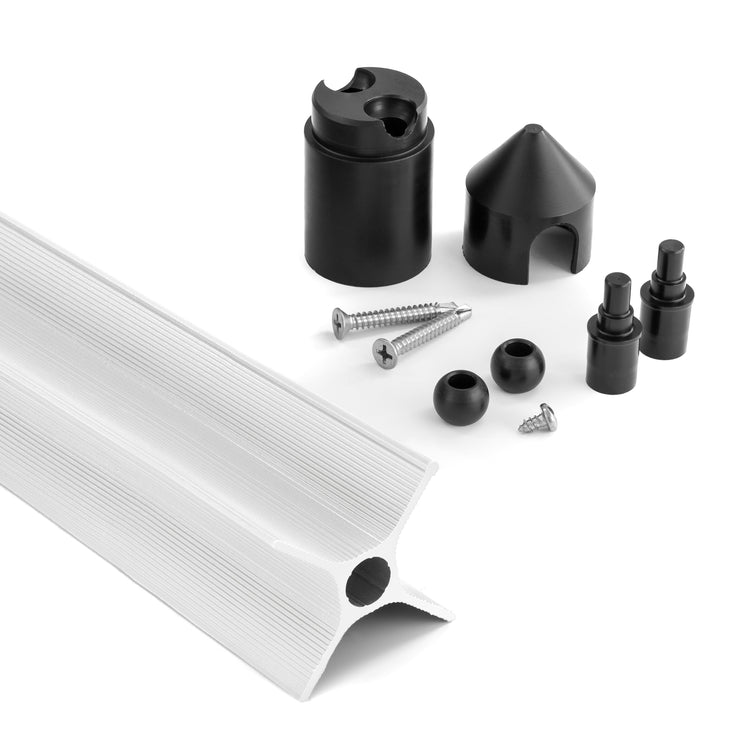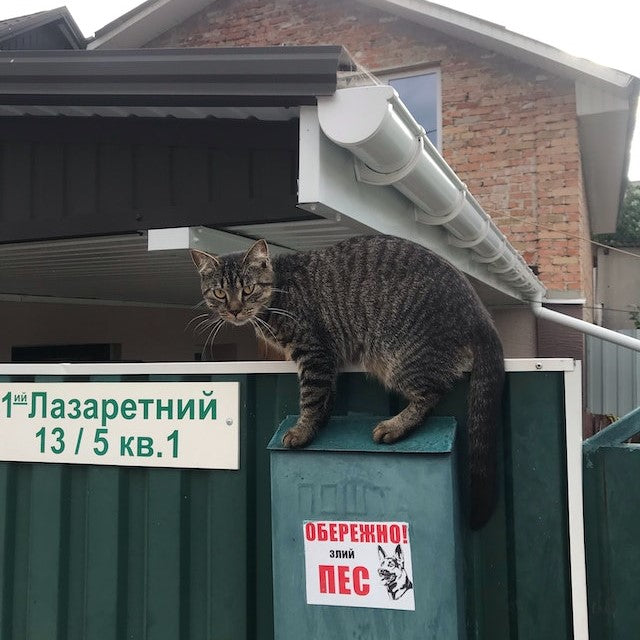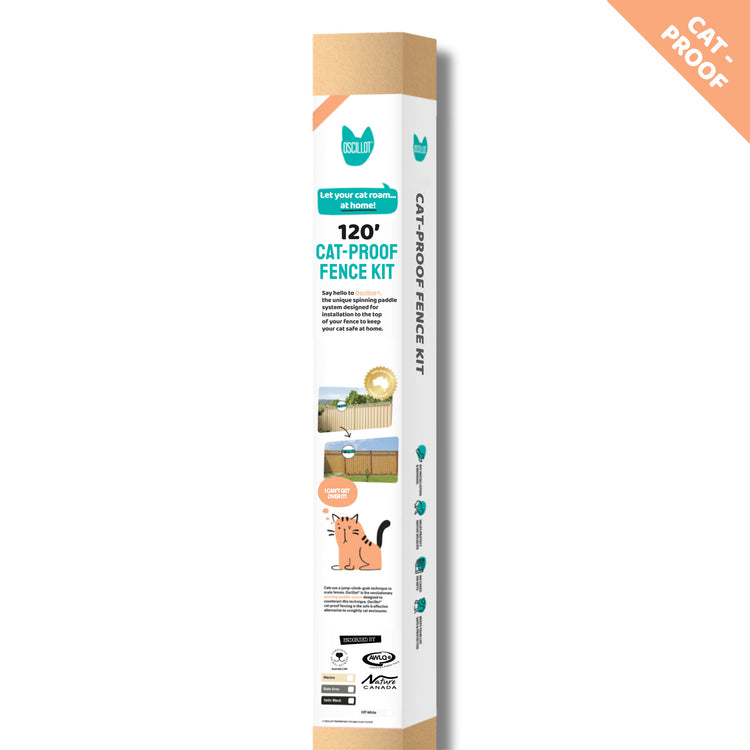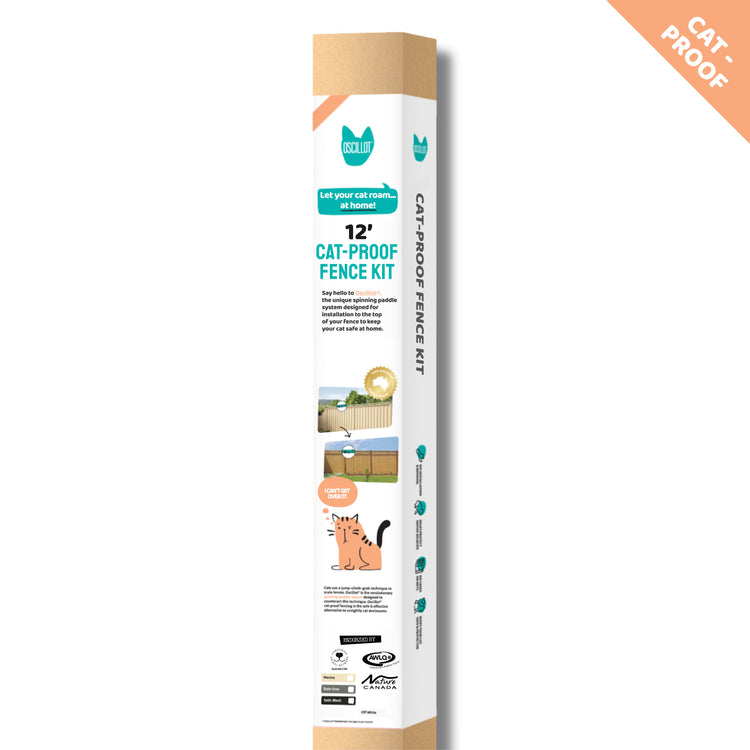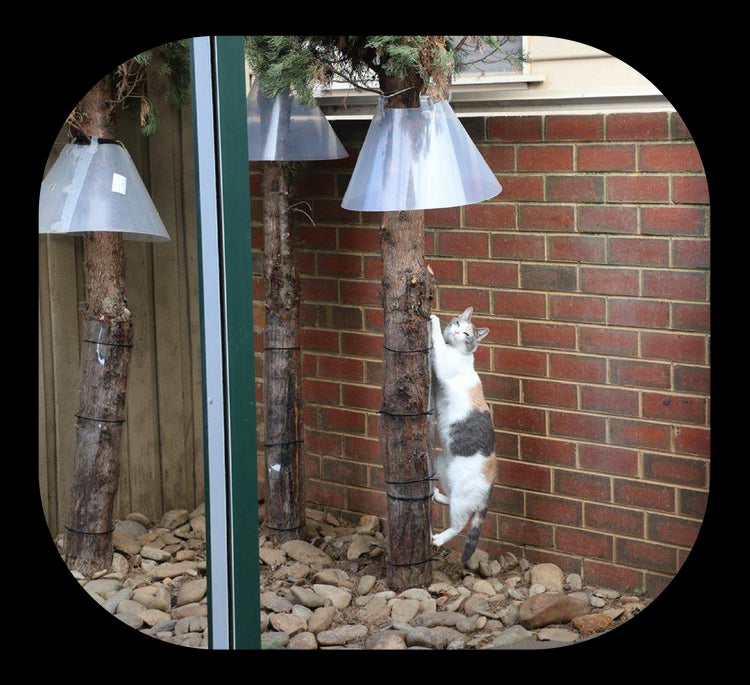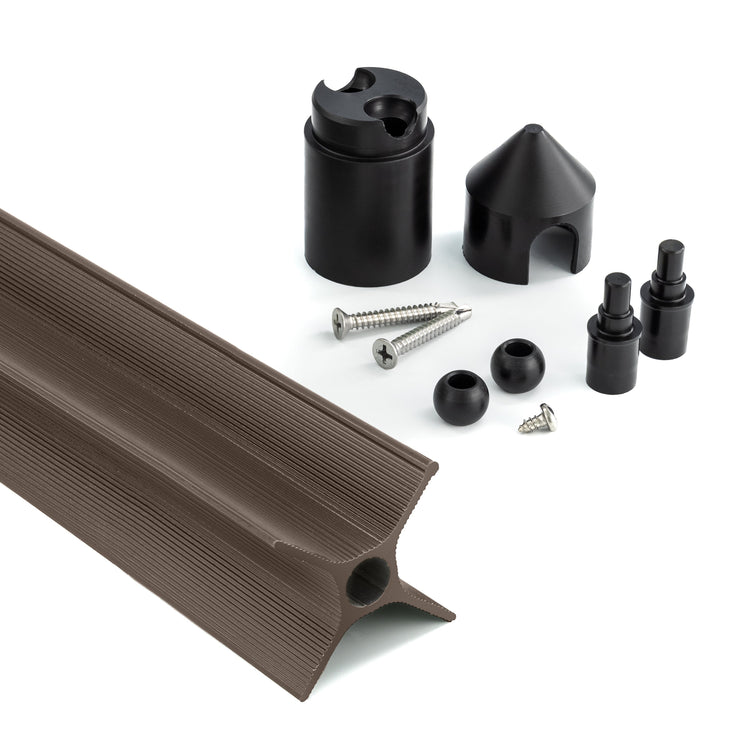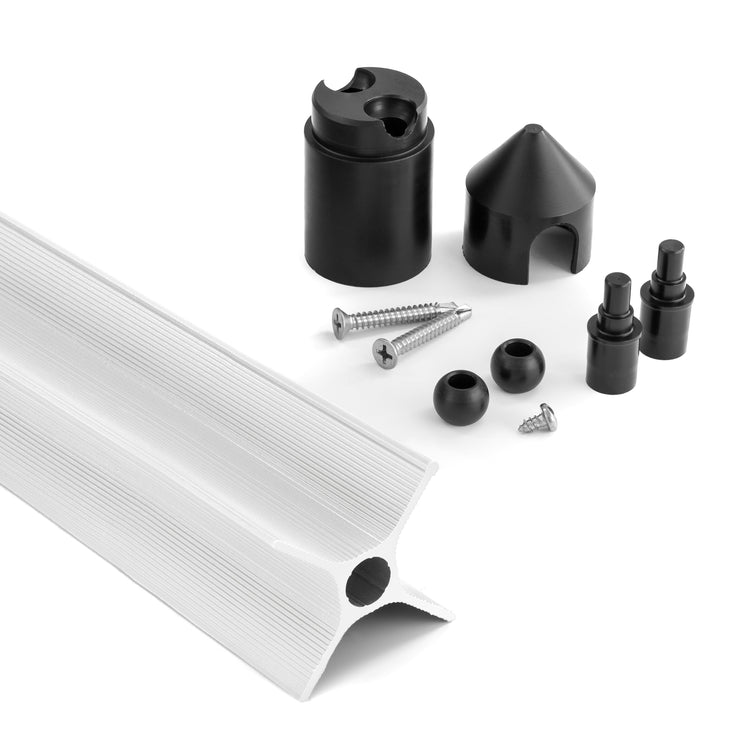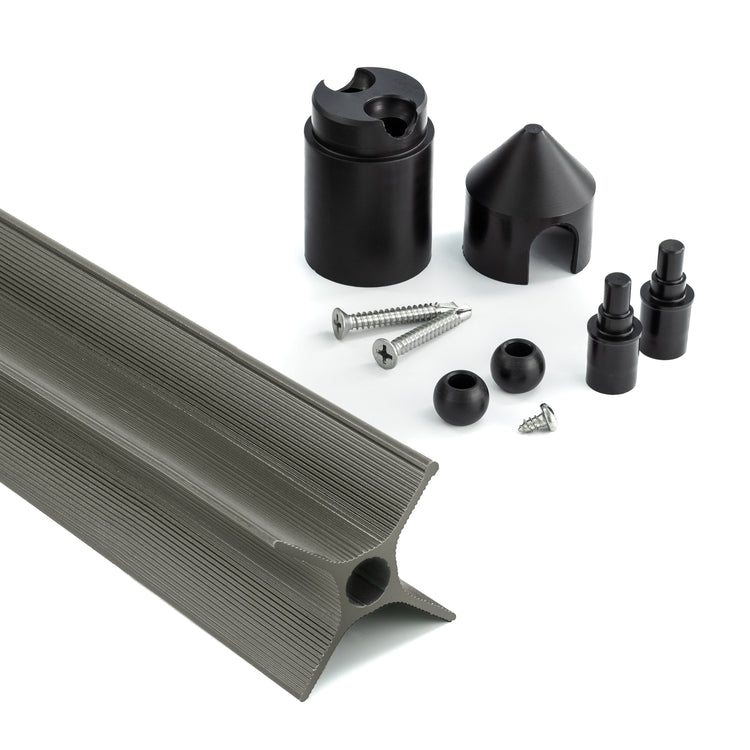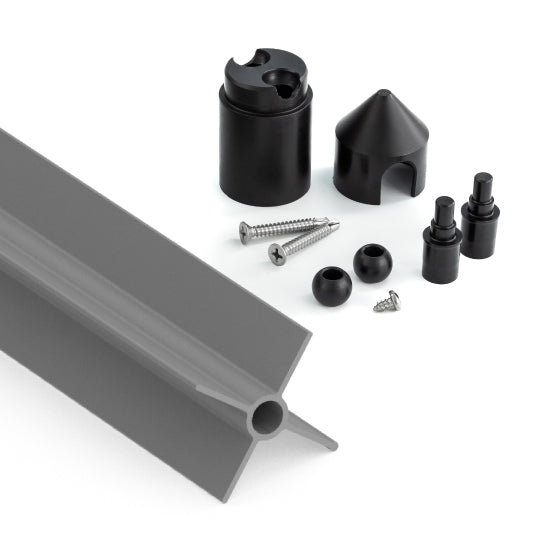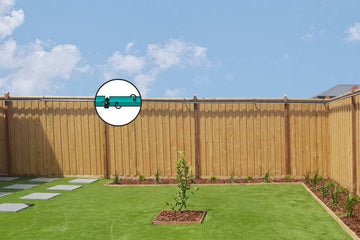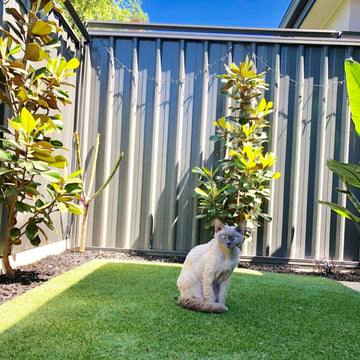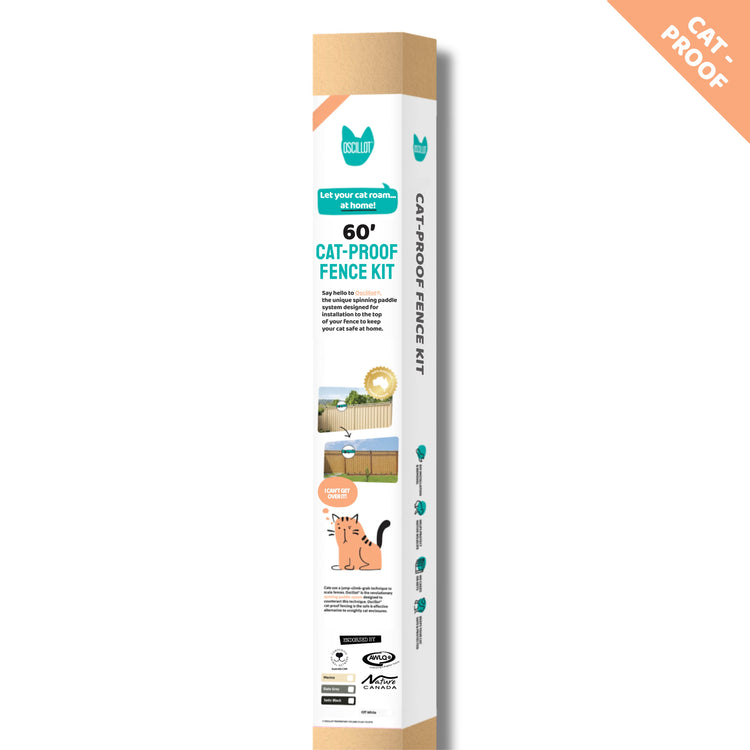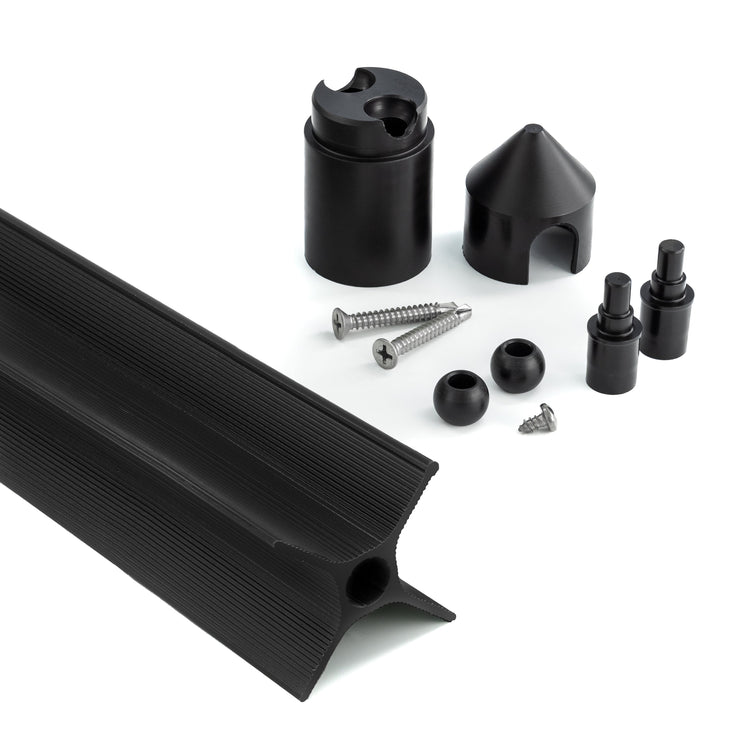Ihren Zaun auf starke Winde und Stürme vorbereiten: Vollständiger Schutzleitfaden

Wichtige Erkenntnisse
- Gründliche Inspektionen zweimal jährlich reduzieren das Sturmschadenrisiko erheblich
- Tiefe Pfosteninstallation (mindestens 1/3 der Pfostenhöhe) bietet kritische Windbeständigkeit
- Verschiedene Zaunmaterialien benötigen spezifische Schutzbehandlungen und Wartungspläne
- Strategische Verstärkungstechniken können die Windbeständigkeit um bis zu 40% erhöhen
- Küsten- und Starkwindgebiete benötigen spezialisierte Materialien und Installationsmethoden
- Nachsturmbewertung innerhalb von 24 Stunden verhindert, dass kleinere Schäden zu größeren Reparaturen werden
Einleitung: Warum die Sturmsicherung Ihres Zauns wichtig ist
Starke Winde und schwere Stürme können Ihr Eigentum beschädigen, wobei Zäune oft die ersten Dinge sind, die bei schlechtem Wetter brechen. Ein Zaun ist mehr als nur ein Grenzmarkierung; er ist eine Investition in die Sicherheit Ihres Eigentums und Seelenruhe, besonders für die sichere Eindämmung von Haustieren. Wetterbedingte Zaunschäden machen etwa 25% aller Zaunreparaturen jährlich aus, was ein großes Anliegen für Hausbesitzer in Gebieten ist, die viele Stürme bekommen.
Die Vorbereitung Ihres Zauns vor der Sturmsaison kann einen großen Unterschied zwischen einem Zaun, der stark durch schlechtes Wetter bleibt, und einem, der teure Reparaturen oder Ersatz benötigt, machen. Ob Sie ein katzensicheres Zaunsystem oder eine hundesichere Zauninstallation haben, präventive Maßnahmen zu ergreifen ist wichtig für langfristige Haltbarkeit. Studien zeigen, dass gut gewartete und verstärkte Zäune Windgeschwindigkeiten bis zu 30% höher als Zäune ohne präventive Pflege standhalten können, was möglicherweise Tausende an Reparaturkosten über die Zeit spart.
Dieser Leitfaden zeigt Ihnen praktische Schritte zur Vorbereitung Ihres Zauns auf starke Winde und Stürme und stellt sicher, dass Ihr Eindämmungssystem unabhängig vom Wetter funktioniert. Wir werden behandeln, wie verschiedene Wetterereignisse verschiedene Zaunmaterialien beeinflussen und spezifische Wege zur Stärkung Ihres Zauns. Experten empfehlen einen systematischen Ansatz zum Zaunschutz, der regelmäßige Wartung mit strategischen Verbesserungen kombiniert, um die Festigkeit Ihres Zauns während schwieriger Wetterereignisse zu maximieren.
1. Bewertung des aktuellen Zustands Ihres Zauns
Bevor Sie mit der Sturmsicherung Ihres Zauns beginnen, müssen Sie seinen aktuellen Zustand überprüfen. Diese Überprüfung ist die Grundlage für alle Ihre Vorbereitungsmaßnahmen. Laut Zaunbranchenstatistiken hätten etwa 65% der sturmbedingten Zaunausfälle durch ordnungsgemäße Inspektion und frühzeitige Wartung verhindert werden können, was zeigt, wie wichtig dieser erste Schritt wirklich ist.
Worauf Sie während der Inspektion achten sollten
Beginnen Sie mit der Untersuchung Ihrer Zaunpfosten, da diese das Rückgrat Ihres gesamten Zaunsystems bilden. Prüfen Sie auf:
Wackelnde oder sich neigende Pfosten sind ein großes Warnzeichen, das ein geschwächtes Fundament zeigt. Diese Pfosten werden wahrscheinlich bei starken Winden versagen und möglicherweise ganze Zaunabschnitte zum Einsturz bringen. Studien zeigen, dass ein Pfosten, der sich nur 5 Grad neigt, bis zu 30% seiner Festigkeit verlieren kann, was dies sehr wichtig zu überprüfen macht. Achten Sie auch auf Anzeichen von Fäulnis oder Rost, besonders auf Bodenhöhe, wo sich Feuchtigkeit sammelt. Holz zeigt weiche, verfärbte Bereiche, während Metall Abblättern, Grübchenbildung oder orange-braune Flecken haben kann. Achten Sie besonders auf die Stelle, wo der Pfosten auf den Boden trifft, da dieser Bereich die meiste Verschlechterung erfährt.
Hardwareprobleme sind ein weiterer häufiger Schwachpunkt. Überprüfen Sie alle Halterungen, Schrauben und Befestigungselemente, um sicherzustellen, dass sie fest und sicher sind. Lose Verbindungen schaffen schwache Stellen, die bei starken Winden schnell versagen können. Forschung zeigt, dass bis zu 40% der Zaunausfälle an Verbindungspunkten beginnen, anstatt bei den Materialien selbst. Vergessen Sie nicht, Ihre Zaunpaneele auf Verziehen, Aufspaltung oder andere Schäden zu prüfen, die die Struktur schwächen könnten. Achten Sie besonders auf Bereiche, die zuvor repariert wurden, da diese oft Schwachstellen bei extremem Wetter sind. Experten empfehlen einen systematischen Ansatz, Ihren Zaun in Abschnitte zu teilen und alle gefundenen Probleme sorgfältig zu dokumentieren.
Für Oscillot-Systeme speziell stellen Sie sicher, dass alle Komponenten sicher befestigt sind. Unsere hundesicheren Zaun-Kits und katzensicheren Zaun-Kits sind darauf ausgelegt, haltbar zu sein, aber regelmäßige Inspektion ist immer noch wesentlich. Die rotierenden Paddel sollten sich frei bewegen, ohne zu klemmen, und alle Montagehardware sollte fest und rostfrei sein.
Erstellen einer Wartungscheckliste
Entwickeln Sie einen systematischen Ansatz zur Zauninspektion mit dieser praktischen Checkliste:
Beginnen Sie damit, um Ihren gesamten Zaun zu gehen und beide Seiten zu untersuchen, wenn möglich. Dies gibt Ihnen einen vollständigen Blick auf den Zustand Ihres Zauns aus allen Blickwinkeln. Versuchen Sie, zu verschiedenen Tageszeiten zu prüfen, um Probleme zu erkennen, die in bestimmtem Licht sichtbarer sein könnten. Während Sie Problembereiche finden, markieren Sie sie mit wetterfesten Tags oder machen Fotos zur Referenz. Diese Dokumentation hilft Ihnen, Probleme zu verfolgen und Reparaturen zu priorisieren. Das Erstellen einer digitalen Aufzeichnung mit datierten Fotos bietet wertvolle Vergleichspunkte für zukünftige Inspektionen und kann wichtig für Versicherungsansprüche bei Sturmschäden sein.
Testen Sie die Stabilität jedes Pfostens, indem Sie sanften Druck in verschiedene Richtungen ausüben. Ein fester Pfosten sollte sich kaum bewegen. Industriestandards schlagen vor, dass sich Pfosten nicht mehr als 1-2 Zoll bewegen sollten, wenn moderater Druck am oberen Ende ausgeübt wird. Überprüfen Sie auch, dass Tore ordnungsgemäß schließen und einrasten - diese sind oft die ersten Teile, die bei starken Winden versagen. Tor-Hardware verschleißt schneller als statische Zaunkomponenten und braucht typischerweise doppelt so häufig Wartung. Überprüfen Sie den Boden um Pfosten auf Erosion oder Wasserstau, was die strukturelle Integrität über die Zeit schwächen kann. Es ist gut, eine leichte Neigung weg von Zaunpfosten zu erhalten, um Wasseransammlung zu verhindern.
Vergessen Sie nicht, auf Vegetationswachstum zu prüfen, das Ihren Zaun beeinträchtigen könnte. Reben und Kletterpflanzen können Gewicht und Windwiderstand hinzufügen, während Wurzeln Pfostenfundamente stören können. Experten empfehlen, mindestens 30 cm Abstand zwischen holzigen Pflanzen und Zaunstrukturen zu halten. Dokumentieren Sie alle Ihre Ergebnisse zum Vergleich bei zukünftigen Inspektionen und erstellen eine Wartungsgeschichte, die hilft, sich entwickelnde Probleme zu identifizieren, bevor sie ernst werden. Viele Immobilienverwalter verwenden Bewertungssysteme (wie eine 1-5 Skala), um den Zustand verschiedener Zaunabschnitte über die Zeit zu verfolgen.
Regelmäßige Überprüfungen, idealerweise zweimal jährlich und vor Sturmsaisonen durchgeführt, ermöglichen es Ihnen, den Zustand Ihres Zauns über die Zeit zu verfolgen und kleine Probleme zu beheben, bevor sie zu größeren Problemen werden. Wartungsstatistiken zeigen, dass für jeden ausgegebenen Euro für präventive Zaunwartung etwa 4 Euro Reparaturkosten über die Lebensdauer des Zauns gespart werden.
2. Verstehen, wie verschiedene Zaunmaterialien auf extremes Wetter reagieren
Verschiedene Zaunmaterialien haben einzigartige Schwächen und Stärken beim Umgang mit harschem Wetter. Das Verstehen dieser Eigenschaften ist wesentlich für die Umsetzung der richtigen Schutzstrategien. Forschung zeigt, dass Umweltfaktoren die erwartete Lebensdauer von Zäunen um 20-50% ohne ordnungsgemäße Wartung und Schutzmaßnahmen reduzieren können.
Metallzäune (Aluminium und Stahl)
Metallzäune, wie die Aluminiumkomponenten, die in unseren Oscillot hundesicheren Zaun-Kits verwendet werden, bieten ausgezeichnete Haltbarkeit gegen Wind, erfordern aber spezifische Pflege. Tests zeigen, dass ordnungsgemäß installierte Metallzäune Windgeschwindigkeiten bis zu 70 mph ohne erhebliche Schäden widerstehen können, was sie zu einer der stärksten verfügbaren Optionen macht.
Der Hauptvorteil von Metallzäunen ist ihre beeindruckende Windbeständigkeit. Anders als Holz oder Vinyl absorbiert Metall keine Feuchtigkeit, was das Verziehen und die Verschlechterung verhindert, die oft bei anderen Materialien auftreten. Studien zeigen, dass hochwertiges Aluminium bis zu 95% seiner Festigkeit auch nach Jahrzehnten der Außenexposition beibehalten kann. Die starre Struktur von Metallzäunen ermöglicht es ihnen, erheblichem Winddruck zu widerstehen, ohne sich unter normalen Umständen zu biegen oder zu brechen. Tests zeigen, dass sich Metallzäune etwa 40% weniger unter gleichen Windlasten verbiegen im Vergleich zu Vinyl-Alternativen.
Allerdings haben Metallzäune auch einige Schwächen. In Küstengebieten kann Salzexposition die Korrosion beschleunigen, besonders bei Stahlkomponenten. Forschung zeigt, dass unbehandelter Stahl in Küstenumgebungen bis zu 10-mal schneller korrodieren kann als an Binnenstandorten. Sogar Aluminium, das von Natur aus korrosionsbeständiger ist, kann in diesen Umgebungen ohne ordnungsgemäßen Schutz Probleme entwickeln. Auch während Metallzäune selbst hohen Winden standhalten können, können sie dennoch durch fliegende Trümmer während Stürmen beschädigt werden. Während Aluminium sich leicht biegen kann, um Aufpralle zu absorbieren, bleiben direkte Treffer von schweren Trümmern ein erhebliches Risiko.
Um Metallzäune zu schützen, wenden Sie regelmäßig Schutzbeschichtungen in Küstenumgebungen oder Gebieten mit hoher Luftfeuchtigkeit an. Überprüfen und ziehen Sie lose Komponenten als Teil Ihrer Routinewartung an, da Verbindungen zwischen Pfosten und Paneelen oft die ersten Ausfallpunkte während Stürmen sind. Die Verwendung von Sicherungsscheiben oder Gewindesicherungsmitteln bei wichtigen Befestigungselementen kann windinduziertes Lockern verhindern.
Unsere Aluminiumkomponenten sind speziell dafür ausgelegt, schwierigen Bedingungen zu widerstehen und gleichzeitig ihre Funktionalität und ihr Aussehen zu bewahren, was sie zu einer ausgezeichneten Wahl für sturmgefährdete Gebiete macht. Die in unseren Systemen verwendeten Legierungen enthalten spezifische Zusätze, die die Korrosionsbeständigkeit um bis zu 60% im Vergleich zu Standard-Aluminiumprodukten verbessern.
Vinyl/PVC-Zäune
Vinylzäune bieten gute Flexibilität bei starken Winden, erfordern aber ordnungsgemäße Installation. Tests zeigen, dass hochwertiges Vinyl sich um bis zu 25% ohne permanente Verformung biegen kann, was es ihm ermöglicht, bei Böen "nachzugeben", anstatt unter Druck zu brechen.
Einer der wichtigsten Vorteile von Vinylzäunen ist ihre Flexibilität. Bei starken Winden können sich Vinylpaneele leicht biegen, ohne zu brechen, was ihnen ermöglicht, etwas Windenergie zu absorbieren, anstatt ihr vollständig zu widerstehen. Diese Eigenschaft hilft Vinylzäunen oft, Stürme zu überstehen, die starrer strukturierte Zäune beschädigen könnten. Moderne Vinylformulierungen enthalten Schlagzähigkeitsmodifikatoren, die ihre Fähigkeit, dynamischen Kräften zu widerstehen, erheblich erhöhen. Zusätzlich ist Vinyl von Natur aus feuchtigkeitsbeständig, was Bedenken über Fäulnis, Schimmel oder Mehltau eliminiert, die Holzzäune plagen. Hochwertige Vinylmaterialien können ihre Wasserbeständigkeitseigenschaften über 30+ Jahre mit minimaler Verschlechterung beibehalten.
Trotz dieser Vorteile hat Vinyl seine eigenen Schwächen. Bei extrem kalten Temperaturen kann Vinyl spröde werden, was es wahrscheinlicher macht, dass es bei Treffern durch fliegende Trümmer während Stürmen reißt. Tests zeigen, dass die Schlagfestigkeit um bis zu 60% abnehmen kann, wenn die Temperaturen unter den Gefrierpunkt fallen. Die leichte Natur von Vinyl bedeutet auch, dass es besonders sichere Verankerung erfordert, um zu verhindern, dass ganze Abschnitte während starker Winde verschoben werden. Vinylzäune erfahren etwa 30% mehr Auftriebskraft als vergleichbare Holzstrukturen aufgrund ihres geringeren Gewichts.
Für maximale Sturmbeständigkeit stellen Sie sicher, dass Vinylzaunpfosten tief mit ordnungsgemäßen Betonfundamenten gesetzt sind. Wo möglich, verstärken Sie Vinylkomponenten mit Metalleinsätzen, besonders an Stresspunkten. Diese einfachen Maßnahmen können die Sturmwiderstandsfähigkeit von Vinylzäunen erheblich verbessern. Installationsprofis empfehlen Betonfundamente, die sich mindestens 15 cm über den Pfostendurchmesser hinaus erstrecken, um ausreichende Stabilisierung in weichen Böden zu bieten.
Holzzäune
Während weniger üblich für Haustier-Eindämmungssysteme, erfordern Holzzäune die meiste Vorbereitung für Stürme. Forschung zeigt, dass sogar druckimprägniertes Holz bis zu 10% seiner strukturellen Festigkeit jährlich ohne ordnungsgemäße Wartung in harschen Umgebungen verlieren kann.
Holzzäune sehen schön aus und können relativ einfach mit zusätzlichen Verstrebungen oder Stützen verstärkt werden. Viele Hausbesitzer schätzen das natürliche Aussehen und die Möglichkeit, Holzzäune durch Beizen oder Streichen anzupassen. Holzzäune bleiben die am meisten anpassbare Option, mit unzähligen Designvariationen möglich, um Aussehen mit Sturmbeständigkeit zu balancieren.
Allerdings ist Holz sehr anfällig für Feuchtigkeitsschäden, was zu Fäulnis, Verziehen und struktureller Schwächung über die Zeit führen kann. Unbehandeltes Holz kann bis zu 25% seines Gewichts in Feuchtigkeit absorbieren, was zu dimensionalen Änderungen führt, die Befestigungselemente und Verbindungen belasten. Winddruck kann erheblichen Stress auf Holzzäune verursachen, besonders wenn sie altern und verwittern. Ohne ordnungsgemäße Behandlung und Wartung haben Holzzäune oft die kürzeste Lebensdauer in sturmgefährdeten Gebieten. Unbehandelte Holzzäune in feuchten Klimazonen können binnen 3-5 Jahren nach der Installation strukturelle Verschlechterung zeigen.
Um Holzzäune zu schützen, wenden Sie regelmäßig wasserfeste Versiegelungen an - typischerweise alle 1-2 Jahre je nach Ihrem Klima. Ersetzen Sie beschädigte Bretter umgehend, um die strukturelle Integrität zu erhalten, und erwägen Sie windresistente Designs wie Shadowbox-Stile, die etwas Luft durchlassen und so den Gesamtwinddruck auf den Zaun reduzieren. Experten empfehlen penetrierende Versiegelungen, die sich mit den Holzfasern verbinden, anstatt nur einen Oberflächenfilm zu bilden, für maximalen Schutz gegen Feuchtigkeit.
Verbundmaterialien
Moderne Verbundzäune kombinieren Haltbarkeit mit ästhetischer Anziehungskraft. Studien zeigen, dass hochwertige Verbundmaterialien bis zu 85% ihrer ursprünglichen Festigkeit nach 20 Jahren Außenexposition beibehalten können, was traditionelles Holz erheblich übertrifft.
Verbundzaunmaterialien bieten mehr Feuchtigkeitsbeständigkeit als traditionelles Holz und erfordern weniger häufige Wartung bei Beibehaltung eines ähnlichen Aussehens. Diese Materialien kombinieren typischerweise Holzfasern mit Plastikpolymeren und schaffen ein Produkt, das Fäulnis, Insekten und Verziehen besser widersteht als natürliches Holz. Hochwertige Verbundmaterialien absorbieren weniger als 1% ihres Gewichts in Feuchtigkeit, verglichen mit bis zu 25% für unbehandeltes Holz.
Wie andere Materialien können Verbundzäune dennoch durch aufschlagende Trümmer während Stürmen beschädigt werden. Während sie allgemein haltbarer als Holz sind, können Verbundmaterialien über die Zeit bei UV-Exposition verblassen, obwohl dies primär ein Aussehensanliegen ist und kein strukturelles. Moderne Verbundmaterialien enthalten jetzt UV-Hemmer, die das Farbverblassen um bis zu 70% im Vergleich zu frühen Generationsprodukten reduzieren können.
Für maximalen Sturmschutz führen Sie regelmäßige Inspektionen auf lose Komponenten durch und stellen sicher, dass ordnungsgemäße Pfosteninstallation mit ausreichender Tiefe und Betonstütze erfolgt. Verbundzäune funktionieren oft gut in verschiedenen Wetterbedingungen, wenn sie ordnungsgemäß installiert und gewartet werden. Installationsexperten empfehlen die Verwendung von rostfreien Stahlfeststellern mit Verbundmaterialien, um die Korrosion zu verhindern, die bei Standardbefestigungen auftreten kann.
Bei Oscillot verwenden unsere Katzeneindämmungssysteme Qualitätsmaterialien, die speziell für Haltbarkeit in verschiedenen Wetterbedingungen ausgewählt wurden, und bieten Seelenruhe während Sturmsaisonen. Unser Ingenieursteam führt umfangreiche Umwelttests durch, um sicherzustellen, dass Komponenten die Funktionalität in Temperaturbereichen von -20°C bis +50°C beibehalten.
3. Wesentliche Verstärkungstechniken für Windbeständigkeit
Die Umsetzung strategischer Verstärkung ist einer der effektivsten Wege, die Widerstandsfähigkeit Ihres Zauns gegen starke Winde und Stürme zu erhöhen. Diese Techniken können die strukturelle Integrität Ihres bestehenden Zaunsystems erheblich verbessern. Studien zeigen, dass ordnungsgemäß umgesetzte Verstärkung die Windbeständigkeit um 30-50% im Vergleich zu Standardinstallationen erhöhen kann.
Verstärkung von Zaunpfosten
Die Pfosten sind die Grundlage der Festigkeit Ihres Zauns und machen sie kritisch für Windbeständigkeit. Tests zeigen, dass Pfostenversagen etwa 70% der katastrophalen Zaunkollapsse während schwerer Stürme ausmacht.
Erwägen Sie, kritische Pfosten in einer Tiefe von mindestens 1/3 ihrer Gesamtlänge neu zu installieren. Diese tiefere Installation bietet bei starken Winden erheblich mehr Stabilität. Zum Beispiel sollte ein 1,80 m hoher Zaunpfosten mindestens 60 cm in den Boden hineinragen, wobei 90 cm in sturmgefährdeten Gebieten noch besser sind. Forschung zeigt, dass eine Erhöhung der Pfostentiefe von 1/4 auf 1/3 der Gesamthöhe den seitlichen Widerstand um bis zu 40% in den meisten Bodentypen verbessern kann.
Verwenden Sie hochwertigen Beton für Pfostenfundamente und stellen sicher, dass ordnungsgemäße Entwässerung erfolgt, um Wasseransammlungen zu verhindern, die das Fundament über die Zeit schwächen könnten. Experten empfehlen eine minimale Druckfestigkeit von 3000 PSI für Zaunpfostenanwendungen, um ausreichende Stütze zu bieten. Installieren Sie Schutzkappen an Pfostenoberkanten, um zu verhindern, dass Wasser eindringt, was besonders wichtig für Holzpfosten ist, die von innen heraus faulen können. Interne Pfostenverfallprozesse verlaufen oft 2-3 mal schneller als sichtbare äußere Verschlechterung. Das Hinzufügen von Metallhalterungen an der Pfostenbasis bietet zusätzliche Stabilität, besonders für Eckpfosten, die während Stürmen die meiste Belastung erfahren. Ordnungsgemäß installierte Metallhalterungen können die seitliche Belastungskapazität eines Pfostens um 25-35% erhöhen.
Unsere Oscillot hundesicheren Zaun-Kits enthalten verstärkte Dual-Knuckle-Pfostensätze, die speziell dafür entwickelt wurden, Stabilität auch unter schwierigen Bedingungen zu bewahren. Diese spezialisierten Komponenten haben umfangreiche Windlasttests durchlaufen, um Leistung während Starkwindereignissen sicherzustellen.
Sicherung von Paneel-Verbindungen
Die Verbindungen zwischen Pfosten und Paneelen sind häufige Ausfallpunkte bei starken Winden. Tests zeigen, dass Standardverbindungen bei Windgeschwindigkeiten von nur 45 mph zu versagen beginnen können, während verstärkte Verbindungen Geschwindigkeiten bis zu 70 mph widerstehen können.
Ersetzen Sie Standardschrauben durch galvanisierte oder rostfreie Stahl-Alternativen, die Korrosion widerstehen und überlegene Haltekraft bieten. Rostfreie Stahlfestigkeitselemente behalten bis zu 95% ihrer Festigkeit nach Jahren der Außenexposition bei, verglichen mit nur 40% bei Standardbefestigern. Die Erhöhung der Anzahl der Verbindungspunkte zwischen Paneelen und Pfosten verteilt Windkraft gleichmäßiger und reduziert Belastung auf einzelne Befestiger. Die Verdopplung der Anzahl der Befestiger kann den Gesamtwindwiderstand um etwa 80% erhöhen, nicht nur 100%, aufgrund verbesserter Lastverteilung. In Hochrisikogebieten erwägen Sie die Installation spezialisierter Hurrikan-Gurte, die speziell für Windbeständigkeit entwickelt wurden. Diese Komponenten können die Verbindungsfestigkeit um 150-200% im Vergleich zu Standardbefestigungsmethoden erhöhen.
Das Hinzufügen zusätzlicher horizontaler Stützen zwischen Pfosten schafft größere strukturelle Integrität, indem es verhindert, dass sich Paneele bei Böen übermäßig biegen. Diese Verstärkungsschienen sind besonders wichtig für höhere Zäune, die mehr Winddruck erfahren. Tests zeigen, dass mittlere Höhenverstärkung die Paneelablenkung um bis zu 60% während Starkwindereignissen reduzieren kann.
Windresistente Design-Modifikationen
Einige Design-Anpassungen können die Windleistung dramatisch verbessern. Studien zeigen, dass strategische Design-Modifikationen Windlasten um 30-50% reduzieren können, ohne Sicherheit oder Ästhetik zu beeinträchtigen.
Erwägen Sie Designs, die etwas Luft durchlassen und so den Gesamtwinddruck auf den Zaun reduzieren. Solide Paneele wirken wie Segel bei starken Winden, während Zäune mit Lücken zwischen Latten etwas Luftstrom ermöglichen und die Gesamtkraft auf die Struktur verringern. Tests bestätigen, dass Zäune mit 20% offenem Raum etwa 30% weniger Windlast erfahren als vollständig solide Designs. Abwechselnde Latten auf gegenüberliegenden Seiten der Schienen schaffen eine stärkere Struktur, die während Stürmen weniger wahrscheinlich versagt. Dieses Shadowbox-Design bietet nicht nur Privatsphäre, sondern schafft auch ein steiferes Paneel mit verbesserten strukturellen Eigenschaften.
Ersetzen Sie solide Oberteile durch Gitterdesigns, die Wind durchlassen und dennoch Privatsphäre und Sicherheit bieten. Gitterabschnitte können den Winddruck um bis zu 40% im Vergleich zu soliden Paneelen gleicher Höhe reduzieren. Die Installation diagonaler Verstrebungen an Eckpfosten und Torpfosten erhöht die Stabilität an diesen kritischen Punkten erheblich. Ordnungsgemäß installierte diagonale Verstrebung kann den Eckpfostenwiderstand gegen seitliche Kräfte um 60-80% erhöhen.
Tor-Verstärkung
Tore sind während Stürmen besonders anfällig und erfordern besondere Aufmerksamkeit. Analysen zeigen, dass Tore etwa dreimal wahrscheinlicher während Stürmen versagen als Standardzaunabschnitte gleicher Größe.
Ersetzen Sie Standardscharniere durch schwerere Alternativen, die für Hochstress-Situationen entwickelt wurden. Diese substanzielleren Scharniere verteilen Gewicht und Winddruck effektiver und verhindern Tor-Durchhang und Versagen. Schwerlast-Scharniere können bis zu dreimal das Gewicht von Standardversionen tragen und dabei Stabilität bewahren. Installieren Sie Fallstangen, die das Tor beim Schließen im Boden sichern und zusätzliche Stabilität bei starken Winden bieten. Ordnungsgemäß installierte Fallstangen können die Widerstandsfähigkeit eines Tors gegen Windkräfte um 70-90% erhöhen, indem sie eine starre Verbindung zum Boden schaffen.
Fügen Sie Querstrebungen hinzu, um Tor-Durchhang und Verziehen zu verhindern, was besonders wichtig für breitere Tore ist, die während Stürmen mehr Hebelkraft erfahren. Diagonale Verstrebung kann die Torablenkung unter Windlast um bis zu 75% reduzieren. Rüsten Sie auf Verschlüsse mit Verriegelungsmechanismen um, die sich bei anhaltender Windexposition nicht durch Vibration öffnen und sicherstellen, dass Ihr Tor während des gesamten Sturms sicher geschlossen bleibt. Standardverschlüsse können beginnen sich zu lockern nach nur 30 Minuten Exposition gegenüber wind-induzierter Vibration, während Verriegelungsversionen für die Dauer typischer Sturmereignisse sicher bleiben.
Durch die Umsetzung dieser Verstärkungstechniken können Sie die Fähigkeit Ihres Zauns, starken Winden und Stürmen zu widerstehen, erheblich verbessern und sowohl Ihre Eigentumsgrenze schützen als auch sicherstellen, dass Ihr Katzeneindämmungssystem oder Ihre Hundebarriere unabhängig von den Wetterbedingungen effektiv bleibt. Tests zeigen, dass umfassende Verstärkung die funktionale Lebensdauer eines Zauns um 40-60% in sturmgefährdeten Regionen verlängern kann.
4. Wetterschutzbehandlungen und Schutzbeschichtungen
Die Anwendung geeigneter Schutzbehandlungen ist wesentlich für die Verlängerung der Lebensdauer Ihres Zauns und die Verbesserung seiner Widerstandsfähigkeit gegen harsches Wetter. Diese Behandlungen schaffen eine Barriere gegen Feuchtigkeit, UV-Schäden und andere Umweltfaktoren. Forschung zeigt, dass hochwertige Schutzbeschichtungen die Zaunlebensdauer um 30-50% in herausfordernden Umgebungen verlängern können.
Schutzbeschichtungen für Metallkomponenten
Für Metallelemente in Ihrem hundesicheren Zaunsystem oder anderen Metallzäunen können spezialisierte Beschichtungen die Lebensdauer dramatisch verlängern. Tests zeigen, dass ordnungsgemäß beschichtetes Metall der Verschlechterung bis zu 5-mal länger widerstehen kann als ungeschützte Komponenten in identischen Umgebungen.
Wenden Sie spezialisierte Metallgrundierungen und Farben an, die speziell dafür entwickelt wurden, Rost und Korrosion zu verhindern. Diese Produkte schaffen eine Schutzbarriere, die das Metall vor Feuchtigkeit und Umweltverunreinigungen schützt. Hochwertige Metallbeschichtungen können Korrosionsraten um 80-95% im Vergleich zu ungeschützten Oberflächen reduzieren. Für maximalen Schutz erwägen Sie Komponenten mit galvanisierten Beschichtungen, die überlegene Beständigkeit gegen Feuchtigkeit durch eine Zinkschicht bieten, die opfernd korrodiert, um das darunterliegende Metall zu schützen. Heißverzinken kann 15-30 Jahre Schutz auch in mäßig korrosiven Umgebungen bieten.
Klare Schutzmittel bieten eine unsichtbare Schutzschicht, ohne das Aussehen Ihres Zauns zu verändern, was besonders nützlich für dekorative Metallelemente ist. Diese Produkte enthalten typischerweise UV-Stabilisatoren und Wasserabweisungsmittel, die Verschlechterung verhindern und gleichzeitig die Ästhetik beibehalten. Für die haltbarste Oberfläche bietet Pulverbeschichtung ausgezeichneten Schutz gegen die Elemente und bewahrt die Ästhetik, mit einer Oberfläche, die typischerweise widerstandsfähiger gegen Absplittern und Kratzen ist als herkömmliche Farbe. Hochwertige Pulverbeschichtung kann Aussehen und Schutz für 15-20 Jahre unter normalen Außenbedingungen bewahren.
Die Aluminiumkomponenten in unseren Oscillot-Systemen verfügen bereits über Schutzbehandlungen, aber zusätzliche Pflege in Küsten- oder extrem nassen Umgebungen kann ihre Lebensdauer weiter verlängern. Unser Aluminium durchläuft einen mehrstufigen Behandlungsprozess, der eine Schutzoxidschicht von etwa 20 Mikrometern Dicke für überlegene Umweltbeständigkeit schafft.
Behandlungen für Holzelemente
Wenn Ihr Zaun Holzelemente enthält, ist ordnungsgemäßer Schutz wesentlich. Forschung zeigt, dass unbehandeltes Holz, das den Elementen ausgesetzt ist, bis zu 25% seiner strukturellen Integrität binnen nur 2-3 Jahren verlieren kann.
Wasserabweisende Konservierungsmittel durchdringen das Holz, um Feuchtigkeitsaufnahme zu verhindern, die die primäre Ursache von Fäulnis und Verfall ist. Diese Behandlungen ermöglichen dem Holz zu atmen und bieten gleichzeitig Schutz gegen Regen und Luftfeuchtigkeit. Hochwertige Konservierungsmittel können Feuchtigkeitsaufnahme um 60-80% im Vergleich zu unbehandeltem Holz reduzieren. Für zusätzlichen Schutz schützen Beizen mit UV-Schutz Holz vor Sonnenschäden und lassen gleichzeitig die natürliche Maserung durchscheinen, was das Verblassen und die Verschlechterung verhindert, die bei anhaltender Sonnenexposition auftreten. UV-schützende Beizen können Farbverschlechterung um bis zu 75% über einen Zeitraum von fünf Jahren reduzieren.
Für maximalen Schutz schafft ein hochwertiges Außenfarben-System mit Grundierung eine haltbare Feuchtigkeitsbarriere, die das Holz vollständig versiegelt. Ordnungsgemäß aufgetragene Farbensysteme können die Holzlebensdauer um 300-400% bei exponierten Bedingungen verlängern. In feuchten Umgebungen verhindern fungizide Behandlungen Schimmel- und Mehltauwachstum, was nicht nur das Holz beschädigen, sondern auch gesundheitliche Bedenken schaffen kann. Hochwertige fungizide Behandlungen können Pilzwachstum für bis zu 5 Jahre hemmen, auch in Umgebungen mit relativer Luftfeuchtigkeit konstant über 80%.
Anwendungszeitpunkt und -häufigkeit
Für optimalen Schutz beachten Sie diese Anwendungsrichtlinien basierend auf umfangreichen Feldtests und Herstellerforschung:
Wenden Sie Schutzbeschichtungen unmittelbar nach der Installation an, bevor der Zaun den Elementen ausgesetzt wird. Diese anfängliche Behandlung bietet eine Grundlinie des Schutzes, die hilft, frühe Verschlechterung zu verhindern. Materialien, die vom ersten Tag der Installation geschützt sind, halten typischerweise 15-25% länger als solche, die nach bereits begonnener Verwitterung behandelt werden. Entwickeln Sie einen Wartungsplan für die Neuanwendung von Behandlungen entsprechend den Herstellerempfehlungen, typischerweise alle 2-3 Jahre je nach Ihrem Klima und dem spezifischen verwendeten Produkt. Die Einhaltung dieses regelmäßigen Plans kann den Schutz um bis zu 300% im Vergleich zum Warten bis sichtbare Verschlechterung auftritt verlängern.
Wenden Sie Behandlungen während trockener Perioden mit mäßigen Temperaturen für optimale Absorption und Aushärtung an. Extreme Hitze oder Kälte kann beeinflussen, wie Behandlungen durchdringen und an Oberflächen haften. Anwendung bei Temperaturen zwischen 10-27°C und relativer Luftfeuchtigkeit unter 70% bietet optimale Beschichtungsleistung. Bevor die Sturmsaison ankommt, überprüfen Sie die Beschichtungsintegrität und bessern Sie nach Bedarf aus, um sicherzustellen, dass Ihr Zaun maximalen Schutz hat, wenn schweres Wetter eintrifft. Experten empfehlen, diese Inspektionen mindestens 30 Tage vor typischen Sturmsaisonen zu planen, um ausreichende Zeit für Anwendung und Aushärtung zu ermöglichen.
Besondere Überlegungen für Küstengebiete
Zäune in Küstenumgebungen stehen vor einzigartigen Herausforderungen, die zusätzlichen Schutz erfordern. Studien zeigen, dass Metallverschlechterung bis zu 10-mal schneller innerhalb von 1 Kilometer Salzwasser verglichen mit Binnenstandorten auftreten kann.
Marine-taugliche Oberflächen sind spezialisierte Beschichtungen, die formuliert sind, um Salzsprüh- und hoher Luftfeuchtigkeit zu widerstehen und überlegenen Schutz in diesen herausfordernden Umgebungen zu bieten. Marine-taugliche Beschichtungen können 2.000+ Stunden kontinuierlicher Salzsprühexposition im Vergleich zu 200-500 Stunden für Standard-Außenoberflächen widerstehen. Aufgrund der beschleunigten Korrosion, die in Küstengebieten auftritt, planen Sie häufigere Inspektion und Behandlung - typischerweise zweimal jährlich anstatt der jährlichen Wartung, die für Binnenstandorte ausreichend ist. Schutzbeschichtungen in Küstenzonen verschlechtern sich etwa 2,5-mal schneller als identische Produkte in nicht-küstennahen Regionen.
Für Metallzäune in Küstenumgebungen können Opferanoden helfen, galvanische Korrosion zu verhindern, indem sie korrosive Elemente von Ihren Zaunkomponenten wegziehen. Ordnungsgemäß installierte Opferanoden können Korrosionsraten an Hauptstrukturen um bis zu 90% reduzieren. Regelmäßiges Süßwasserspülen entfernt korrosive Salzablagerungen, die sich auf Zaunoberflächen ansammeln und verhindert langfristige Schäden durch Salzexposition. Monatliches Süßwasserspülen kann die Beschichtungslebensdauer um 30-50% in schweren Küstenumgebungen verlängern.
Unser Blog über Schutz Ihres Oscillot-Systems in Küstenumgebungen bietet detaillierte Anleitung für diese herausfordernden Bedingungen, einschließlich spezialisierter Wartungspläne und Produktempfehlungen basierend auf der Nähe zu Salzwasser.
Durch die Umsetzung geeigneter Wetterschutzbehandlungen können Sie die Lebensdauer Ihres Zauns erheblich verlängern und seine strukturelle Integrität durch harsches Wetter beibehalten und sicherstellen, dass Ihr Haustier-Eindämmungssystem das ganze Jahr über effektiv bleibt. Regelmäßige Schutzbehandlungen bieten typischerweise eine Kapitalrendite von 300-400% durch verlängerte Lebensdauer und reduzierte Reparaturkosten.
5. Vorbereitung Ihres Zauns vor der Sturmsaison
Proaktive Schritte zu unternehmen, bevor die Sturmsaison ankommt, kann das Risiko von Schäden an Ihrem Zaun erheblich reduzieren. Dieser präventive Ansatz ist besonders wichtig für die Aufrechterhaltung der Integrität von Haustier-Eindämmungssystemen. Versicherungsdaten zeigen, dass Eigentümer mit dokumentierter Vorstorm-Vorbereitung etwa 60% weniger zaunbezogene Ansprüche nach schweren Wetterereignissen erfahren.
Zeitplanung Ihrer Vorbereitungen
Strategische Zeitplanung ist entscheidend für effektive Sturmvorbereitung. Studien zeigen, dass Vorbereitungsmaßnahmen, die mindestens 30 Tage vor typischen Sturmsaisonen begonnen werden, Schäden um etwa 40% im Vergleich zu Last-Minute-Maßnahmen reduzieren.
Führen Sie gründliche Inspektionen mindestens 4-6 Wochen vor Beginn der Sturmsaison in Ihrem Gebiet durch. Diese Zeitspanne gibt Ihnen ausreichend Zeit, Probleme zu identifizieren und zu beheben, bevor schweres Wetter eintrifft. Diese Pufferperiode zu haben ist kritisch, da sie eine ordnungsgemäße Aushärtung von Versiegelungen oder Reparaturen ermöglicht, bevor sie durch extreme Bedingungen getestet werden. Nach der Inspektion behandeln Sie kritische strukturelle Probleme sofort und priorisieren Reparaturen, die die Stabilität und Integrität des Zauns beeinträchtigen. Strukturelle Reparaturen, die mindestens 14 Tage vor potenziellen Stürmen abgeschlossen werden, sind 3-4 mal effektiver als Notfallreparaturen, die unmittelbar vor Wetterereignissen vorgenommen werden.
Schließen Sie alle Routinewartungen weit vor vorhergesagten Stürmen ab, einschließlich der Anwendung von Schutzbehandlungen, des Anziehens von Hardware und der Beseitigung von Vegetation. Schutzbeschichtungen benötigen typischerweise 7-14 Tage, um maximale Wirksamkeit zu erreichen, was eine frühe Anwendung wesentlich macht. Als Vorsichtsmaßnahme führen Sie eine letzte Überprüfung aller Systeme 48-72 Stunden vor einem vorhergesagten Sturm durch, um sicherzustellen, dass alles sicher ist und ordnungsgemäß funktioniert. Diese abschließende Überprüfung hilft, neue Probleme zu beheben, die sich seit den anfänglichen Vorbereitungen entwickelt haben könnten.
Für Regionen mit definierten Hurrikan- oder Monsunsaisonen bieten unsere wetterfesten Zaun-Lösungen saisonspezifische Anleitung basierend auf Wettermustern und historischen Wetterdaten für verschiedene geografische Regionen.
Erstellen einer Vorstorm-Checkliste
Folgen Sie dieser umfassenden Checkliste, um sicherzustellen, dass Ihr Zaun sturmbereit ist. Studien zeigen, dass die Verwendung eines systematischen Checklisten-Ansatzes die Vorbereitungseffizienz um bis zu 70% im Vergleich zu Ad-hoc-Methoden erhöhen kann.
Entfernen Sie alle Trümmer, Spielzeuge und lose Gegenstände um Ihren Zaun, die bei starken Winden zu Geschossen werden könnten. Sogar kleine Gegenstände können erheblichen Schaden verursachen, wenn sie von sturm starken Winden angetrieben werden, wobei die Aufprallkräfte exponentiell mit der Windgeschwindigkeit zunehmen. Schneiden Sie Bäume und Sträucher zurück, die fallen oder gegen den Zaun wehen könnten und unnötigen Druck oder Schäden verursachen. Experten empfehlen, mindestens 90 cm Abstand zwischen Vegetation und Zaunstrukturen in sturmgefährdeten Gebieten zu halten. Stellen Sie sicher, dass Wasser frei von Zaunpfosten wegfließen kann, um Erosion und Fundamentschwächung bei starken Regenfällen zu verhindern. Ordnungsgemäße Entwässerung kann Pfostenfundamentschäden um bis zu 80% bei starken Niederschlagsereignissen reduzieren.
Sichern Sie alle losen Schrauben, Bolzen und Befestiger, da diese kleinen Komponenten oft die ersten sind, die während Stürmen versagen. Sogar leicht lockere Befestiger können nach nur 15-20 Minuten Exposition gegenüber sturmniveau Vibrationen vollständig lösen. Überprüfen Sie, dass Torverschlüsse sicher sind, und erwägen Sie zusätzliche temporäre Verstrebungen für Tore, die typischerweise die verwundbarsten Zaunkomponenten sind. Temporäre Verstrebung kann den Tor-Windwiderstand um 40-60% mit minimalen Materialien und Aufwand erhöhen. Machen Sie Fotos Ihres Zauns für Versicherungszwecke und dokumentieren seinen Zustand vor dem Sturm, falls Sie später einen Anspruch einreichen müssen. Versicherungsansprüche, die durch Vorstorm-Dokumentation unterstützt werden, werden bis zu 40% schneller bearbeitet und werden eher vollständig genehmigt.
Haben Sie Materialien für schnelle Nachsturm-Reparaturen zur Hand, einschließlich Ersatzhardware, Werkzeuge und Reparaturmaterialien, die für Ihren Zauntyp geeignet sind. Es ist gut, ein spezielles Reparatur-Kit speziell für Zaunnotfälle zu unterhalten, da diese Materialien oft nach weit verbreiteten Sturmereignissen knapp sind.
Temporäre Verstärkungsoptionen
Für besonders schwere Wettervorhersagen erwägen Sie diese temporären Maßnahmen. Feldtests zeigen, dass temporäre Verstärkungen die Sturmüberlebensraten um 30-50% für Zäune in direkten Windpfaden erhöhen können.
Installieren Sie diagonale Stützen auf der Windseite verwundbarer Abschnitte, besonders für höhere Zaunpaneele, die mehr Winddruck erfahren. Temporäre diagonale Verstrebung, die in einem 45-Grad-Winkel installiert wird, kann die seitliche Lastwiderstand um bis zu 70% für Standard-Zaunabschnitte erhöhen. In einigen Fällen können windresistente Planen den Winddruck auf solide Paneele reduzieren, indem sie eine aerodynamischere Oberfläche schaffen, die etwas Luft durchlässt. Ordnungsgemäß gesicherte winddurchlässige Abdeckungen können die Gesamtwindlast um 30-40% im Vergleich zu festen Oberflächen gleicher Größe reduzieren.
Platzieren Sie Sandsäcke an der Basis von Pfosten in hochwassergefährdeten Gebieten, um zusätzliches Gewicht und Stabilität bei Hochwasserereignissen zu bieten. Diese einfache Maßnahme kann Pfosten-Verschiebung in Wassertiefen bis zu 30 cm mit mäßigen Fließgeschwindigkeiten verhindern. Für extrem schwere Stürme erwägen Sie, Tortüren temporär zu entfernen, um Schäden durch Windstress an diesen verwundbaren Komponenten zu verhindern. Tore erfahren 3-5 mal mehr Stress als feste Paneele bei starken Winden aufgrund ihrer beweglichen Natur und größeren ungestützten Spannweiten.
Besondere Überlegungen für Haustier-Eindämmung
Wenn Sie unsere katzensicheren Zaunsysteme oder hundesicheren Zaun-Kits verwenden, unternehmen Sie diese zusätzlichen Schritte, um fortgesetzte Wirksamkeit während und nach Stürmen sicherzustellen.
Überprüfen Sie alle Paddelkomponenten, um sicherzustellen, dass sich alle rotierenden Elemente frei bewegen und sicher befestigt sind. Diese beweglichen Teile sind wesentlich für die Wirksamkeit des Systems, können aber von Trümmern oder Schäden betroffen sein. Sogar kleinere Hindernisse können Paddelrotation um 50-70% reduzieren und möglicherweise die Eindämmungsfunktion des Systems beeinträchtigen. Bestätigen Sie, dass alle Montagehalterungen fest gesichert sind, da diese Verbindungspunkte bei starken Winden erheblichen Stress erfahren. Ordnungsgemäß gesicherte Halterungen können Kräften bis zu 5-mal größer widerstehen als solche, die während normalem Betrieb erfahren werden.
Entfernen Sie angesammelte Blätter oder Trümmer, die die Funktionalität beweglicher Teile beeinträchtigen könnten, da diese Mechanismen verklemmen und Wirksamkeit reduzieren können. Trümmeransammlung ist für etwa 65% der mechanischen Ausfälle in rotierenden Außenkomponenten verantwortlich. Am wichtigsten ist, haben Sie einen Plan, Haustiere während extremem Wetter sicher drinnen zu halten, da sogar das sicherste Eindämmungssystem während schwerer Stürme beeinträchtigt werden kann. Haustier-Fluchtvorkommnisse steigen um bis zu 30% während schwerer Wetterereignisse, was Indoor-Eindämmung zu einer kritischen Sicherheitsmaßnahme macht.
Durch die systematische Vorbereitung Ihres Zauns vor der Sturmsaison können Sie das Risiko von Schäden erheblich reduzieren und sicherstellen, dass Ihr Haustier-Eindämmungssystem durch harsches Wetter effektiv bleibt. Umfassende Sturmvorbereitung bietet typischerweise eine Kapitalrendite von 500-700% durch verhinderte Schäden und verlängerte Systemlebensdauer.
6. Besondere Überlegungen für Küsten- und Starkwindgebiete
Zäune in Küstenregionen und Gebieten, die zu starken Winden neigen, stehen vor einzigartigen Herausforderungen, die spezialisierte Ansätze zur Sturmvorbereitung erfordern. Diese Umgebungen erfordern besondere Aufmerksamkeit für Materialauswahl, Installationsmethoden und Wartungsroutinen. Daten zeigen, dass Küstengebiete Windgeschwindigkeiten 20-30% höher als Binnenstandorte während identischer Sturmsysteme erfahren können, was erheblich größeren Stress auf Zaunstrukturen schafft.



